#honey bees
Explore tagged Tumblr posts
Text

World governments have been ordered to crack down on honey bees as the globalist elites escalate the war on farmers and prepare the groundwork for the devastating global famine that WEF insiders have warned us about.
https://rumble.com/v4xdq9h-wef-orders-govts-to-burn-millions-of-bees-to-usher-in-global-famine.html
#the great awakening#wef#government corruption#world economic forum#bill gates#the great reset#world famine#honey bees#farming under attack#illegal immigration#joe biden#fjb#democrats
2K notes
·
View notes
Text

save the bees! 🐝 8.30.18
#bees#honey bee#save the bees#honey bees#bees art#beeswax#bee speaks#buzz#honey#flower#flowers#bugs#bugblr#bug talks#plant aesthetic#photoblog#photographer#photographers on tumblr#photooftheday#photograph#photography#original photographers#canon#original photography on tumblr#pnw#pacific northwest#quick shot#nature#seattle washington#seatac
162 notes
·
View notes
Text

Summer Sweetness.
August 2024.
IPhoneSE
#photographers on tumblr#original photographers#devon#honey bees#bee#nature photography#nature#insects#flowers
352 notes
·
View notes
Text

Flower Bees! <3
#digital art#art#artists on tumblr#artwork#drawing#artoftheday#cute drawing#illustration#cute#artistsoninstagram#bee#bees#bee art#honey#honeybee#cutie honey#honey bees#honey bee#yellow#flower#flowers#pollen#buzz#photo#sun#sunny#cute art#soft art#art style#kawaii art
359 notes
·
View notes
Text
Uncharismatic Fact of the Day
Asian giant hornets are well known for preying on honeybees, and as the largest hornet species in the world they may seem indominatble. However, Japanese honey bees have developed a tried and true technique for defending their homes: when they sense a hornet coming, about a hundred workers form a shallow tunnel around the hive's entrance, enticing the hornet in. Once the hornet enters the workers surround her and vibrate their bodies. This raises the interior of their ball to 46 °C (115 °F) and releases carbon dioxide, both cooking and suffocating the hornet.
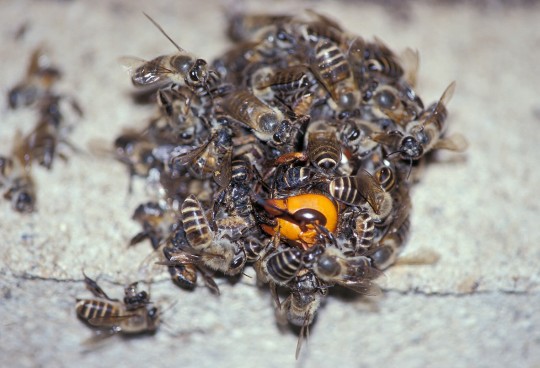
(Image: A group of Japanese honey bees (Apis cerana japonica) surrounding an Asian giant hornet (Vespa mandarinia) by Masato Ono)
#japanese honey bee#Hymenoptera#Apidae#honey bees#bees#asian giant hornet#Vespidae#true hornets#hornets#hymenopterids#insects#arthropods#tw animal death#uncharismatic facts
128 notes
·
View notes
Text

Connecting to the LAN(tana)
#nature#photography#nature photography#flowers#naturecore#floral#summer#summer flowers#pink flowers#yellow flowers#lantana#bee#honey bees#bees
139 notes
·
View notes
Text

Spot the bee 🐝
#nature#outdoors#cottagecore#cottagecore aesthetic#naturecore#flowers#garden#fairycore#bee#save the bees#honey bees#bees
199 notes
·
View notes
Text
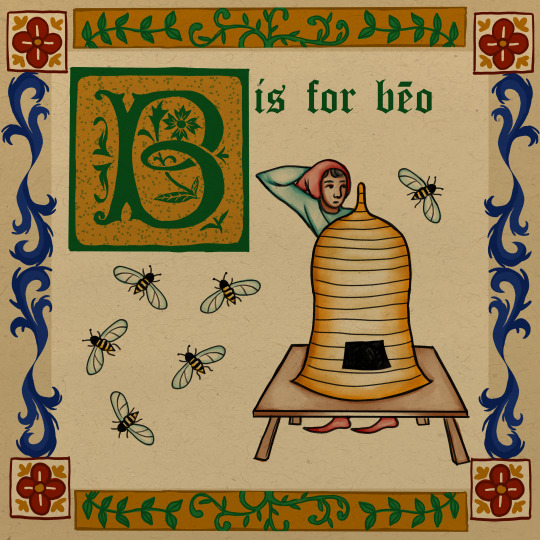
B is for bēo (Old English for bee)
The epic hero Bēowulf's name translates literally to bee-wolf, which is likely a kenning meaning bear.
#my art#artists on tumblr#illustration#medievalism#medieval illustration#illuminated manuscript#historical art#old english#eald englisc#medieval artober#bees#honey bees#apiary#old english alphabet
1K notes
·
View notes
Text
Honeybees are the world’s most important pollinators, but their population is on the decline — here’s how one Bay Area teen discovered a way to repair the effects of pesticides on honeybees 🐝
A brilliant kid for humanity and the planet 🤔
#pay attention#educate yourselves#educate yourself#knowledge is power#reeducate yourself#reeducate yourselves#think about it#think for yourselves#think for yourself#do your homework#do some research#do your own research#ask yourself questions#question everything#honey bees#pollinators#necessary#news#science#smart kids#our future#humanity
214 notes
·
View notes
Text
For #WorldHoneyBeeDay 🐝 here are two golden illuminations from a pair of famous early 13th c. English bestiaries:
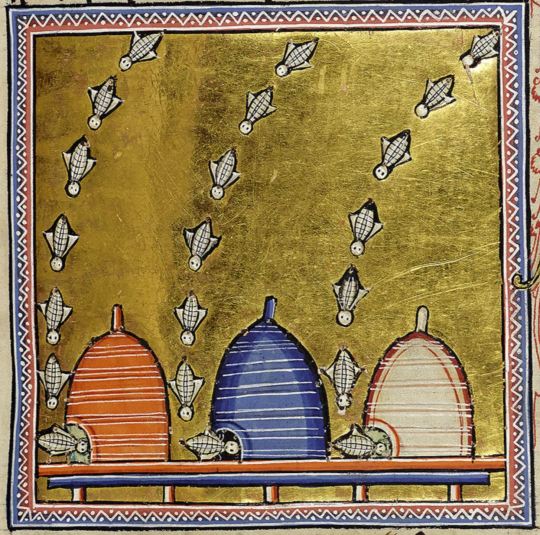
Aberdeen Bestiary, Univ. Lib. MS 24 f.63r Aberdeen University Library
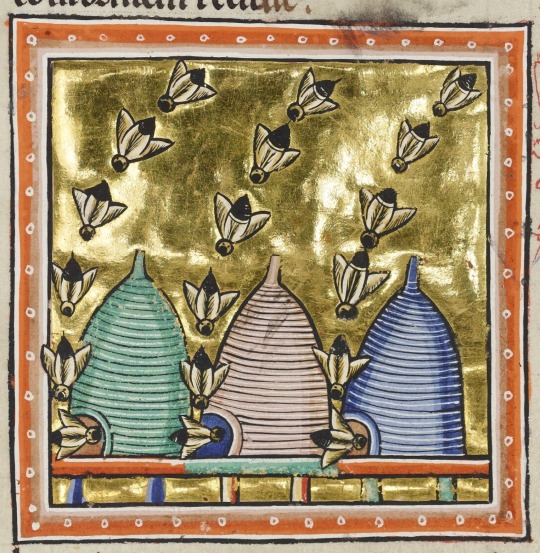
Ashmole Bestiary, MS Ashmole 1511 f.75v Bodleian Libraries
#bee#bees#honeybee#honeybees#honey bee#honey bees#beehive#apiary#medieval art#English art#European art#bestiary#medieval manuscript#illuminated manuscript#illustration#gold leaf#Ashmole Bestiary#Aberdeen Bestiary#Bodleian Libraries#Aberdeen University Library#World Honey Bee Day#animal holiday#animals in art#book art
873 notes
·
View notes
Text

Honey power. 🌼🐻🍯(60”x60” mixed media)🐝
#pop art#contemporary art#fine art#modern art#basquiat#neo expressionism#abstract expressionism#abstract expressionist art#de kooning#andy warhol#keith haring#kenny scharf#jean michel basquiat#honey#raw honey#miel#the beekeeper#beekeeping#bee hive#honey bee#honey bear#propolis#royal jelly#apiary#bumblebee#bumblebees#honey bees#honey comb#manuka honey#art commisions
67 notes
·
View notes
Text





Api bottinatrici di miele e polline
1-2, Onobrychis alba
3, Rubus ulmifolius
4. Teucrium scorodonia
5. Taraxacum sp.
#photographers on tumblr#digital image processing#honey bees#pollination#original photographs#flowers
82 notes
·
View notes
Text
Dandelion News - February 8-14
(I’m finally starting to get better from having had pneumonia for 2+ weeks, hopefully next week’s news should be on time)
Like these weekly compilations? Tip me at $kaybarr1735 or check out my Dandelion Doodles!
1. Solar-powered device captures carbon dioxide from air to make sustainable fuel

“[The] solar-powered reactor could be used to make fuel to power cars and planes[.… It] does not require fossil-fuel-based power, or the transport and storage of carbon dioxide, but instead converts atmospheric CO2 into something useful using sunlight.”
2. How artificial light can boost coral reef recovery

“UZELA is [an autonomous submersible] designed to attract zooplankton […] by emitting specific wavelengths of light. [… In a ”six-month testing period,” it] significantly increased local zooplankton density and boosted the feeding rates of both healthy and bleached coral.”
3. Next-gen solar cells now fully recyclable with water-based method

“The recycled solar cell has the same efficiency as the original one. The solar cell is made of perovskite and the main solvent is water. […] They are not only relatively inexpensive and easy to manufacture but also lightweight, flexible and transparent.”
4. Green walls cool cities and create urban habitats

“The researchers measured a cooling effect of up to 0.6–0.7 degrees Celsius [… which] could help combat the urban heat island phenomenon. […] The researchers [also] found that plant-covered facades hosted over 100 animal species, including insects, spiders, and birds.”
5. Major cause of honeybee mortality can be easily reduced

“If treatment occurs too soon, it may not fully eliminate the mites, allowing them to rebound before the season ends. […] Similar to antibiotic-resistant bacteria, mites that survive mistimed or improperly applied treatments become more resistant to future applications.”
6. Uganda community group restores shea groves and livelihoods

“As part of a larger effort to restore Uganda’s shea parklands, the cooperative has successfully rehabilitated more than 500 hectares (1,240 acres) of degraded land, integrating shea trees (Vitellaria paradoxa) and other native species with maize and sunflower crops.”
7. Senate Renews Commitment to the Great Lakes

“The [Act] represents the most significant federal investment in the health of the Great Lakes, addressing critical challenges such as pollution, invasive species, and habitat restoration. The Great Lakes […] hold 20 percent of the world’s surface freshwater[….]”
8. Earth Gets Its Largest Protected Tropical Forest Reserve

“The Kivu-Kinshasa Green Corridor will […] protect 108,000 square kilometres of primary forest and support 60 million people who depend on the forest for food, energy and jobs. […] Through this approach, the DRC is empowering local communities to protect the forest while fostering economic growth.”
9. Australia’s Rarest Bird of Prey Spotted in Central Australia After 30 Years

“Dr. Henderson’s finding is an encouraging sign of the health of the sanctuary’s ecosystems as well as the bird’s continued migration into new areas. This bird’s presence in the sanctuary is particularly significant as it is the first confirmed sighting in the region since the mid-1990s.”
10. Australian company wins contract to design “hydrogen ready” high speed ferry

“The ferry, the Horizon X, will have capacity for 1,650 passengers and 450 cars, and will be able to travel at a speed of up to 35 knots. […] The ship will also have a specially-designed propulsion system arrangement that repurposes exhaust from the engine to help propel the vessel, in theory reducing its emissions.”
February 1-7 news here | (all credit for images and written material can be found at the source linked; I don’t claim credit for anything but curating.)
#hopepunk#good news#solar power#sustainability#carbon capture#technology#coral reef#ocean#solar panels#solar energy#recycling#green infrastructure#urban heat#urban#biodiversity#honey bees#beekeeping#africa#farming#great lakes#us politics#conservation#nature#australia#birds#endangered species#transportation#ferry#boat#energy efficiency
87 notes
·
View notes
Text
WASP REVIEW - BEES (MINECRAFT)

[Image ID: An official render of the Minecraft bee /End IDs.]
Alright y'all, it's time for an iconic one. One of the most common of only a small handful of arthropods in the game (ironically given the fact they felt the need to specifically make Bane Of Arthropods a thing), and the least hostile one at that, these blocky bees have deservedly buzzed their way into beloved status amongst Minecraft players over the past five years since their official debut. However, as I'm well aware at this point in this series, popularity does not necessarily mean accuracy, so how do these insectoid cuboids really stack up?
Starting from their appearance, it's obvious is that their bodies are heavily fused, with one solid body segment. I'm sure you don't need me to tell you this, but nevertheless, the body of a bee is notably more segmented than the body structure of the Minecraft bee, having three body segments: The head, the mesosoma (also referred to as the thorax, though these are classified a bit differently), and the metasoma (also referred to as the abdomen, same thing here as with the mesosoma). This is clearly a stylistic choice, so I can't get too mad at it, but it is disappointing, given the fact that Minecraft's spider is more segmented, perhaps even having more body segments than the real thing.


[Image Sources: iNaturalist, Yuriy Danilevsky, and PBS, Nebraska Public Media | Image IDs: A photo of a black and yellow/orange European honey bee feeding from a yellow flower, followed by an illustration of a honey bee (female, worker) showing its body parts as labelled. Mandibles, antennae, eyes, thorax, abdomen, stinger, foreleg, middle leg, forewing, hind wing, and hind leg (with labelled pollen basket) /End IDs.]
That said, there are some other things I take issue with regarding this design apart from just this choice of segmentation. I feel like it's safe to assume this bee is based off of the most common honey bee species, the European honey bee (Apis mellifera), in which case, they honestly feel like they're a bit too wide? This wouldn't be a big deal, except, I feel that if they were a bit longer it would help keep the proportions from feeling kind of... Off- Even if we do simplify a bee down to one continuous body segment, it helps to have some distinctions made between the areas of the body. The way they've done it here almost makes it seem as though the mesosoma is just straight up not there; Like the head goes directly into the mesosoma with no in-between.
Another thing that would help this design to not feel quite as "fused together" would be a slight change in coloration. The Minecraft bee has a yellow head, which goes directly into the stripes of the metasoma a little further down the body. In a lot of real world honey bees, the head and mesosoma are generally darker and more solid in color than the lighter and/or more vibrant stripes of the metasoma (with some exceptions), varying in shade depending on the amount of fur (the length of the setae), from a muted yellow to a dark brown color; Further still, honey bee heads can also be noticeably darker overall than the mesosoma at times. Taking this into consideration, I would make the Minecraft bee long enough proportionally to fit another pixel or two lengthwise—enough to provide slightly more space while also not being too long—making the area representing the mesosoma a slightly darker yellow, and the area representing the head the same color as the brown stripes on the original design.
But enough about the body segmentation! Let's talk about the smaller details for a minute here. The wing count is wrong, with only two wings as opposed to the four of a real bee, and they're lacking in terms of venation. The leg count is right but the proportions are all wrong, and they suffer from the same issue as the body, where they look completely fused together. I completely understand wanting to simplify this aspect of the design, but going from five major segments (Coxa, trochanter, femur, tibia, and tarsus) is kind of ridiculous!

[Image Source: bugguide.net | Image ID: An illustrated diagram showing the legs of three Hymenopterans, the first two being of other wasps, while the last one is of a bee, with each segment labeled. Coxa, trochanter, femur, tibia, and tarsus, with metatarsus on the bee. /End IDs.]
The antennae themselves are alright, if a bit short; I appreciate them having little pixels on the main body where they connect to the head, but yeah, it would've been impossible to give them much detail at all at this resolution. The position of the antennae, however, is what throws things off, as they're placed above the eyes when they should be placed between their eyes. Speaking of! Their compound eyes are FAR too small, they should reach up and around the top of their heads, while the eyes here reach only about the halfway point of the texture; and to add insult to injury here, they don't even have their three ocelli (simple eyes)! Nor do they have any mouthparts to speak of, which is an even more major thing to be missing for a bee!

[Image Source: Arizona State University | Image ID: An illustration of the head of a worker honey bee with mouthparts extended, the whole head labelled as follows; Compound Eye, Ocellus (one of three), Antenna, Labrum, Mandible, Maxilla, Labial Palp, Proboscis, and Glossa /End IDs.]
In the end, there's not really much left to cover in regards to this design just due to the fact it's so simplified, though I will say one last thing about it, for now; Their stingers shouldn't be out like that 24/7. Some of their relatives DO have their ovipositors (same thing, a stinger is an ovipositor that can also inject venom) out on the regular, but not bees.

[Image Source: mchoneybeev | Image ID: An in-game screenshot of two Minecraft bees in a cherry forest /End IDs.]
Ok so, what about their behaviors, then? Well, honestly, I think these are actually some of the more accurate ones I've covered in terms of behaviors in this series. Unlike many previous reviews, Minecraft actually goes through the effort of showing that these insects visit and pollinate flowers; Which, barring the ones that are explicitly aliens or robots, would be the case for every Hymenopteran we've covered in the real world. Now, pollination in Minecraft doesn't have an effect on the flowers themselves, it certainly affects the bees!
After visiting a flower, the bees will return to the hive, supplying the hive with honey, as well as beeswax in the form of honeycombs. While this happens much quicker and in larger quantities per trip in the Minecraft bees for purely mechanical reasons, this is relatively accurate to the honey bees of our world, which produce honey from the sugary nectar of flowers, in turn producing more wax as well as they process various bits of plant matter.

[Image ID: An image of a nest made by bees in Minecraft, in the state in which it is full of honey /End IDs.]
We don't actually see these processes happen, however, which I'm sure is partially, fairly enough, because they didn't want to animate it, but it's also because their nest is an enclosed arboreal nest! Bees of the genus Apis primarily prefer to nest in sheltered locations, so the enclosed nature of their nests isn't entirely inaccurate; When they can't find a hollow log or something of the sort, they'll even nest out in the open in the branches of trees. However! These open air nests are exactly that, open! In the instances that they make their hive in the branches of a tree, they will actually make it in a structure that is entirely exposed to the elements, in slabs of honeycomb with no protective outer walls. It's also, perhaps, because of this enclosed shape, and the sheer scaled-up size of the bees in Minecraft (Roughly 0.56 meters if you go by the 1 block = 1 meter measurement) that these nests can only fit a measly three worker bees compared to the upwards of tens of thousands in a real colony of honey bees.
There are actually social bees, though, that produce enclosed nests, made of wax, out in the open, in trees—even producing honey. They're in the same family as the honey bees we know and love, in fact! However, these ones are a part of the genus Trigona, whereas the common European honey bee belongs to the genus Apis.

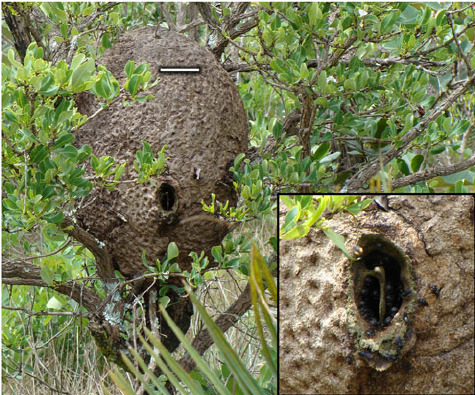

[Image Sources: iNaturalist, Kahio Tiberio Mazon, ResearchGate, Multiple Authors, and AJC, Tim Thompson | Image IDs: A photo of two black and red bees of the species Trigona spinipes on a yellow flower, followed by an image of a nest in a tree made by the same species, followed again by an arboreal nest made by a bee species within the genes Apis, showing how the honeycomb is shaped into slabs exposed to the air /End IDs.]
Some other things we don't seem to see in Minecraft are the queen and drones of the hive! Perhaps understandably so, as queens don't leave the hive many times throughout their lives, and the drones mainly leave the hive to mate with queen bees, along with the fact that there aren't as many drones and queens in a nest as there are workers! This does also further confirm, on top of the presence of their ovipositors, that all the bees we see in minecraft are females! It would be quite fun to see how they would translate the eyes of a drone into this style, however.
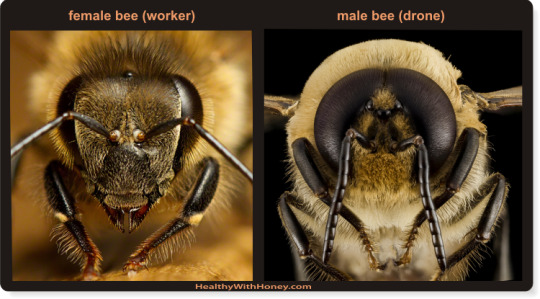
[Image Source: Healthy With Honey | Image ID: A close up set of photos that shows the differences in facial structures between a female, worker bee and a male, drone bee /End IDs.]
Again, on the topic of those ovipositors (I.E., their stingers), how do they attack? Well, thankfully this time there's not anything fantastical about their attack patterns, as they simply sting the player when provoked. Which is another thing! They only attack when provoked; when their hive is attacked, when they're attacked, or when you attempt to harvest from the hive without taking the proper precautions. I feel like this strikes the right balance between being dangerous if messed with and also not being "aggressive", once again unlike many other depictions of Hymenopterans in media in general, as, usually, you get either complete pacifists or murder machines fueled by anger.
Furthermore, when these bees sting you, they take another cue from their real world counterpart and actually lose their stinger! Most bees, ants, and other wasps that are capable of stinging are also capable of doing so more than once; Famously, though, honey bee workers will, more often than not, get their barbed stingers caught in the skin of things like mammals, and lose it. Understandably, Mojang did not depict what actually happens when they lose their stinger, as this leads to the partial disembowelment of the bee, thusly causing it to die.

[Image Source: PBS, Rose-Lynn Fisher | Image ID: An image of a honeybee stinger magnified 650x /End IDs.]
As I mentioned in passing a minute ago, you can, however, absolutely harvest from your hives without aggravating your bees—which doing so could end up potentially killing both you and your bees. With the power of a campfire! And no, of course I'm not suggesting that you burn your bee nest, since, as it turns out, the bees are calmed by smoke! Another well known fact due to the process of beekeeping, as beekeepers usually use smoke to calm bees. I would not necessarily recommend the campfire method, though, as it might be a bit too much in general, and may be a bit too hot for the bees. Even still, relatively cool smoke, applied in just the right amount as to be completely safe for them, will mask alarm pheromones and suppress bees' sense of smell, in turn suppressing their alarm response.
Fittingly, this isn't the only aspect of beekeeping carried over into the Minecraft world, as bees can also be moved from their natural hive into a man-made box hive!

[Image ID: A render of the wooden beehive from Minecraft /End IDs.]
Not much to say here about the structure itself here, as it's made by the player rather than being made in nature. Sadly—and logically due to their equal size—this structure cannot contain any more bees than the natural hive can, however, it still remains useful as the easiest way to move bees from one place to another. That said, I feel it necessary to mention; Due to the fact that, again, we never see a queen, this implies that either these bees have a social structure that is quite different from the real world, or that these bees are leaving their nest without their queen, which would be highly disadvantageous for the colony as a whole, as the queen is the only fertile female! You can even get them to leave individually, which is highly strange behavior for a honey bee. If brought away from the nest, a singular worker bee will typically not attempt to make a new home, and instead try to find a way back to its original home and its queen.
One final thing I want to bring up is that... You can put bees on leads! In fact, this is a major way of bringing the bees from a natural hive to a wooden one. This would be highly impractical in real life, however, it is very cute!

[Image ID: A screenshot of a Minecraft bee on a lead /End ID.]
With everything out of the way, we're left quite a few aspects that are accurate to the real world, but some strange inaccuracies all over the place as well. I find the design to be one of the least accurate among those I can directly compare to the real world, but certain aspects of their behavior, as well as the care put into including certain details, redeem them somewhat. Still, their behavior does contain some inaccuracies as well; So, these blocky bees get my accuracy rating of-
-
Overall: 4.5 to 5/10
-
Leave your wasp review suggestion in the replies, tags, or askbox!
55 notes
·
View notes
Text

Honey Bee Cupcake!
The Bee's are back!
I'm really starting to like drawing these cupcakes, I think they look aesthetically pleasing to look at <3
#yellow#digital art#art#artists on tumblr#artwork#drawing#cute drawing#illustration#artoftheday#cute#bee#bees#beehive#honey#honeybee#honey bee#honey bees#honeycomb#pollin#cupcake#cupcakes#dessert#sticker#stickers#sticker art#stickercore#sticker shop#bee aesthetic#cottagecore
108 notes
·
View notes